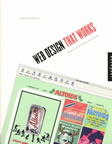 It’s
the conundrum of Web design: There are millions of sites and so few worth
visiting. The fact that anyone with a computer can publish a site is a
big part of the problem—and unfortunately for many companies, this
is their only Web strategy.
It’s
the conundrum of Web design: There are millions of sites and so few worth
visiting. The fact that anyone with a computer can publish a site is a
big part of the problem—and unfortunately for many companies, this
is their only Web strategy.
A common misconception is that if you’ve already worked in design and have learned the language, you can jump right into Internet design. But there’s much more to Web design than code. The Web is vastly different from print, or any other design discipline, for that matter. Successful Web design means taking a different tack, considering the user experience first and embellishments second to create a dynamic, provocative, active destination.
Despite the fact that the number of people using the Web is growing exponentially—literally the majority of the population—the number of sites servicing this booming traffic will eventually shrink and thesurvivors will be the ones who have anticipated and met user needs. Here are some elements you’ll find in successful sites.
TURN THE TABLES
If you’ve ever been told that you never know someone until you take
a walk in their shoes, you already know the first rule of successful Web
design. Web design is about creating an active experience for your visitors,
so it is paramount to not only research what your audience wants but to
really pinpoint the specifics. By 2001 there will be an estimated one
hundred million websites. This means that users will and are losing patience
plowing through the numerous sites that turn up with each search, so you
must offer a focused and well-organized site in order to survive.
CONTENT, CONTENT, CONTENT
Simply put, content is the most valuable resource any site has. The more,
the better, just make sure it’s good and always keep it updated.
Content is the hook, and keeping it updated will keep users coming back.
NAVIGATION
A site can have the greatest, most innovative content ever, but without
an intuitive site-navigation system, it will all be lost on users. Users
simply won’t spend time hunting for information—they know there’s
always something somewhere else. The key is to keep the access to your
content as intuitive and linear as possible. Link and cross link information,so
there’s more than one way to find it.
MAKE A CONNECTION
It doesn’t matter who you are—you’ve got competition.With
the millions of pages vying for visitors’ time, sites need to do
more than passively post information. The site should be a point of interaction—where
users become active participants. This could include feedback forms, interactive
games, or registering visitors and using their preferences to deliver
a personalized experience. The important thing is engaging users as active
participants.
All this makes for great advice in theory, but how do you put it into
practice? Here are some sites that use their design to maketheir site
a valuable tool.